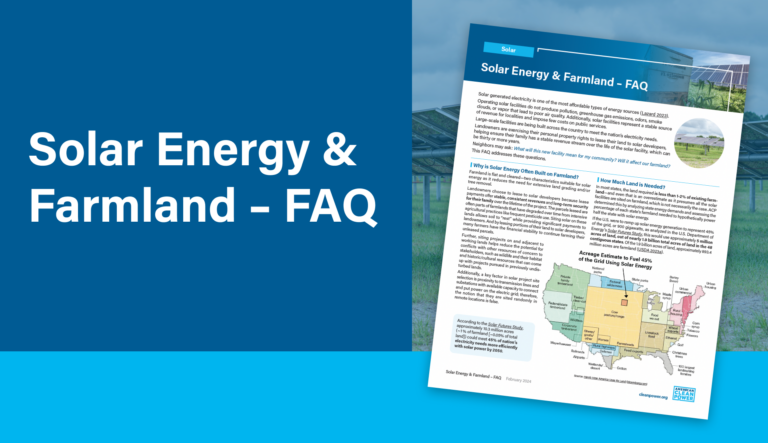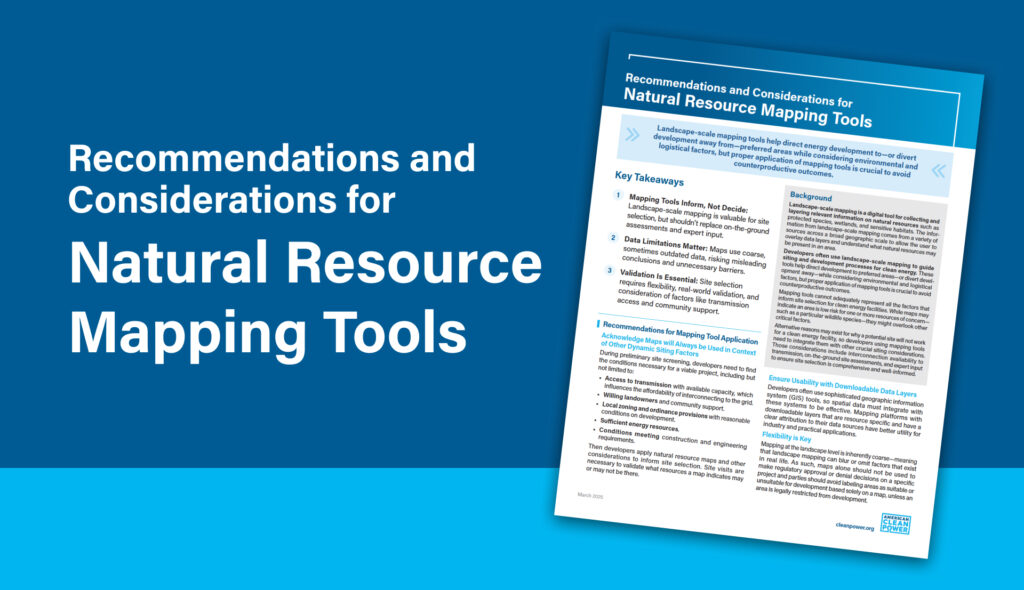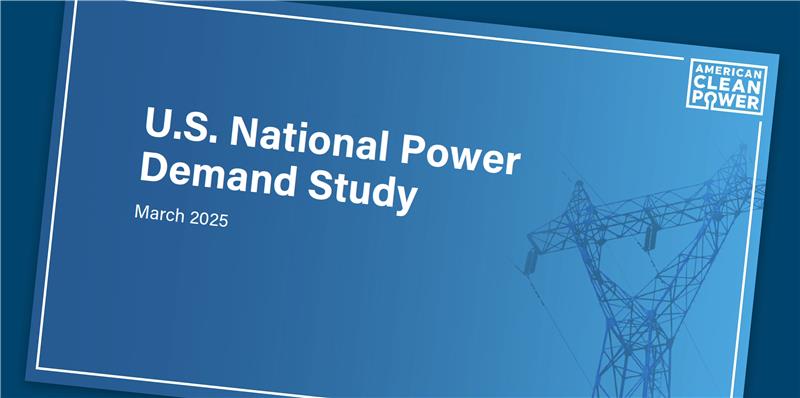Solar generated electricity is one of the most affordable types of energy sources.
Operating solar facilities do not produce pollution, greenhouse gas emissions, odors, smoke clouds, or vapor that lead to poor air quality. Additionally, solar facilities represent a stable source of revenue for localities and impose few costs on public services.
Large-scale facilities are being built across the country to meet the nation’s electricity needs.
Landowners are exercising their personal property rights to lease their land to solar developers, helping ensure their family has a stable revenue stream over the life of the solar facility, which can be thirty or more years.
Neighbors may ask: What will this new facility mean for my community? Will it affect our farmland?
This FAQ addresses these questions.
Why is Solar Energy Often Built on Farmland?
Farmland is flat and cleared—two characteristics suitable for solar energy as it reduces the need for extensive land grading and/or tree removal.
Landowners choose to lease to solar developers because lease payments offer stable, consistent revenues and long-term security for their family over the lifetime of the project. The parcels leased are often parts of farmlands that have degraded over time from intensive agricultural practices like frequent pesticide use. Siting solar on these lands allows soil to “rest” while providing significant payments to landowners. And by leasing portions of their land to solar developers, many farmers have the financial stability to continue farming their unleased parcels.
Further, siting projects on and adjacent to working lands helps reduce the potential for conflicts with other resources of concern to stakeholders, such as wildlife and their habitat and historic/cultural resources that can come up with projects pursued in previously undisturbed lands.
Additionally, a key factor in solar project site selection is proximity to transmission lines and substations with available capacity to connect and put power on the electric grid; therefore, the notion that they are sited randomly in remote locations is false.
How Much Land is Needed?
In most states, the land required is less than 1-2% of existing farmland— and even that is an overestimate as it presumes all the solar facilities are sited on farmland, which is not necessarily the case.
For example, if the U.S. were to ramp up solar energy generation to represent 45% of the grid, or 900 gigawatts, as analyzed in the U.S. Department of Energy’s Solar Futures Study, only 0.6% of existing farmland would be required or 5 million acres of land, out of nearly 1.9 billion total acres of total land in the 48 contiguous states, of which is approximately 893.4 million acres are farmland.
Nationally, about 77 gigawatts of solar energy are currently deployed, enough to power 18 million homes.
Many farmers are already contributing to domestic energy generation in the form of ethanol fuel for vehicles with approximately 40 million acres of corn grown (~4.5 % of farmland) per year going to ethanol production.
How Will the Land Within the Solar Facility be Managed?
After construction, topsoil is reapplied to help revegetate the site and establish ground cover. Revegetation helps prevent erosion, manage stormwater, and support the surrounding ecosystem. Operations personnel maintain the vegetation, inspect the facility, make necessary repairs, and ensure efficient operations.
Are There Impacts on Adjacent Farmlands?
The solar industry strives to be good stewards of the land and strongly values being good neighbors. To protect adjacent farmlands from potential impacts, objectives for all project sites include:
- Enhancing soil stabilization by establishing and maintaining regionally appropriate vegetation cover for the life of the project
- Integrating native seed mixes where feasible and consistent with minimizing soil erosion
- Minimizing the introduction of noxious and invasive weeds in compliance with the state and local policies around invasive species management
- Increasing vegetative diversity of the site when possible
- Reducing chemical applications such as pesticides and herbicides
- Maintaining vegetation to mitigate fire risk
To regulate erosion and stormwater runoff concerns, a locality or state typically requires an erosion and sedimentation control plan before issuing a permit to a solar project. Some sites require grading prior to the construction process; if topsoil is removed, it is stockpiled and redistributed to support soil stabilization and maintain quality. Some developers use preconstruction seeding as a mechanism to stabilize soil early in the installation process. The local authority or relevant state agency often monitor the site until vegetative ground cover is established.
How Do Solar Facilities Preserve Farmland?
Decreasing crop prices—combined with increasing costs to farms— have left many farmers with few alternatives for increasing profits.
Many landowners face pressures to discontinue farming and sell their land to a commercial or residential real estate developer. Development of a commercial or residential subdivision is permanent conversion of land to non-agricultural uses.
In contrast, if requested by the landowner or as a permit condition, a solar facility can be decommissioned at the end of its operational life (approximately 30 years), infrastructure removed, and land can be returned to a condition similar to pre-construction condition. If topsoil is removed during construction of the project, it is stockpiled and redistributed following construction activities to support soil stabilization and maintain site health and quality.
Additionally, solar panels pose little to no environmental risk to the soil or surrounding community during construction, operation, removal, and disposal. The internal components of modules are protected from the elements, particularly moisture, in order to prevent corrosion and the release of materials. ACP’s Solar Panel Recycling and Disposal fact sheet contains additional information on the safety of solar panels, materials used, and how they’re disposed.
During operations of the solar project, where appropriate and feasible, activities such as sheep grazing or other sustainable vegetation management practices can provide additional benefits to the land (which requires a site-specific assessment). This is one example of agrivoltaics and is defined as agricultural production. The co‐location of solar PV and agriculture can provide agricultural enterprises with diversified revenue sources and ecological benefits, while reducing land use competition and siting restrictions.
Can I Continue to Farm and / or Graze Cattle on My Property Up to the Solar Facility’s Fence?
Yes—farming, cattle grazing, and solar energy production can coexist adjacent to each other.
Solar energy is a passive use of the land that allows landowners leasing only a portion of their land and neighboring farmers to continue to farm and produce crops adjacent to the facility. Vegetation at solar facilities does not generally require long-term or routine applications of fertilizer, herbicides, and pesticides. Thus, residual nutrients and contaminants are less likely to affect neighboring crops and livestock. Site vegetation like perennial grasses further stabilize the soil, decreasing runoff and erosion potential, which can potentially improve water quality by intercepting sediment and nutrients.
Fencing around the facility protects the cattle, solar panels and associated infrastructure from damage caused by cattle walking through the facility and rubbing against the panels or other infrastructure. However, cattle can continue to graze near the fenced facility with little risk of harm.
What Assurances Do Agricultural Communities Have that the Land can be Farmed in the Future?
Solar construction and development practices can ensure that the land underneath the panels can “rest” for over 30 years, and upon project decommissioning, return to its previous land use. Once an array is installed, perennial vegetation is typically planted underneath the panels to stabilize soils and retain stormwater.
Where appropriate and feasible, activities such as sheep grazing and other sustainable vegetation management practices, including planting pollinator vegetation, provide additional benefits.
Few land-disturbance activities occur onsite over the next thirty-plus years, enabling soil quality benefits to accrue to the land. After the equipment is removed, and soil de-compacted as part of the restoration, the land can be farmed again.
A county or state typically requires a solar developer to post a bond or other form of financial assurance to guarantee there is sufficient finance to cover the costs associated with project decommissioning. That said, some third-party assessments have estimated the steel and aluminum located at the solar facility alone have a re-sale value exceeding the cost of decommissioning.
What are Other Local Benefits of Solar Facilities?
Creates Jobs: Solar projects deliver short- and long- term benefits to a host locality. Construction of the facility requires hundreds of jobs over the course of a year. Solar companies can enter local benefit agreements to attract local workers or contract with local businesses to support the engineering, construction, and operation of the facility. The solar industry employs nearly 253,000 Americans across the U.S. and the manufacturing industry is increasing production capabilities within the U.S. to support the local supply chain.
Improves Environmental Health: Changing temperatures, rain patterns, drought, flooding, and more severe extreme events, such as wildfires are affecting agriculture and rural communities across the U.S., reducing productivity of crops and negatively affecting livestock. Clean energy sources like solar play a critical part in reducing carbon emissions that lead to changing environmental conditions, as well as reducing air pollutants (e.g., particulate matter, nitrogen oxides, and sulfur dioxide) that create smog and can trigger respiratory issues in people with asthma.
In addition to contributing to improved air quality, solar energy saves approximately 60 billion gallons of water a year when compared to other power plants because they do not require water for cooling.
Furthermore, research has demonstrated solar facilities can reduce chemical applications, improve pollinator habitat, reduce nutrient runoff, and retain stormwater compared to other land uses. A project may also maintain vegetative buffers around the facility where appropriate for visual screening to maintain the rural character of a community while adding to soil health.
Other visual tools include agricultural-style fencing around the perimeter of the project that helps blend in with the rural community, when compatible with public safety and electric reliability considerations.
Increases Tax Base for Rural Communities: Tax benefits accrue to the community over the lifetime of the facility. Tax benefits vary state by state—or county to county—but often the annual revenues in the form of real or personal property tax far exceeds the previous land use. This income can help revitalize small, rural communities, which can use this new revenue to improve schools, build roads, and fund police/ fire departments without additional burdens on these resources (e.g., no increased traffic or water usage).
Improves Grid Reliability and Reduces Energy Costs: Solar energy also improves the reliability of the grid. New energy generation projects are required to undergo a rigorous, multi-step study process to assess potential impacts to the grid and fund any necessary upgrades to grid infrastructure before securing an interconnection agreement (ACP’s Interconnection 101 Fact Sheet).
It’s also important to note that battery energy storage can be a component of these projects, which also helps with grid stability.
Especially in warmer areas, when the sun shines, electricity demand increases to power air conditioning units and other appliances. Solar energy generation can match this demand and reduce peak energy needs during daylight hours.
According to the North American Electric Reliability Corporation (NERC), “extreme weather events continue to pose the greatest risk to grid reliability due to the increase in frequency, footprint, duration and severity.” Solar improves the reliability and the security of the grid by diversifying the energy generation portfolio in a given area.
Simply, solar energy helps balance energy supply with electricity demand across the grid leading to a stable electricity grid.





